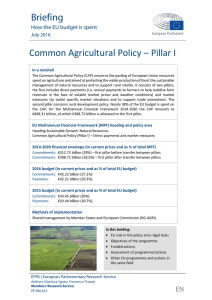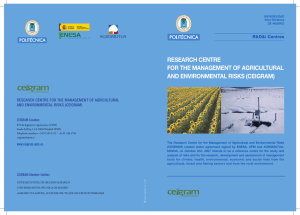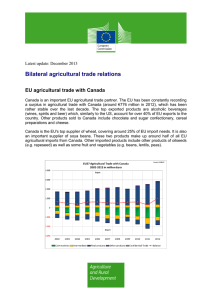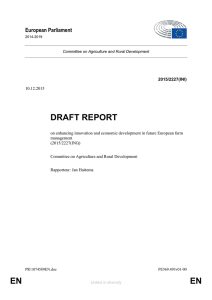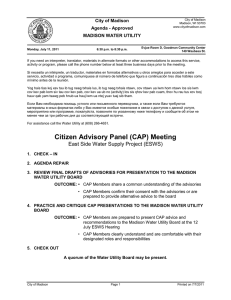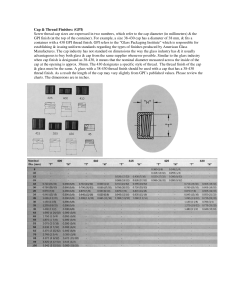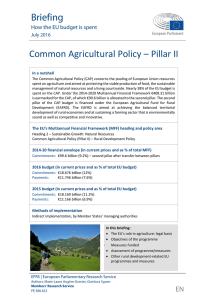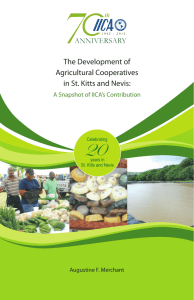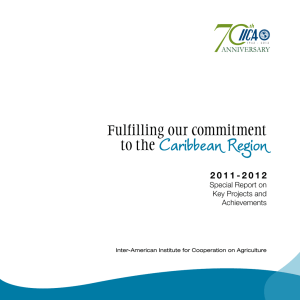Agriculture in the Americas must become more competitive in
Anuncio
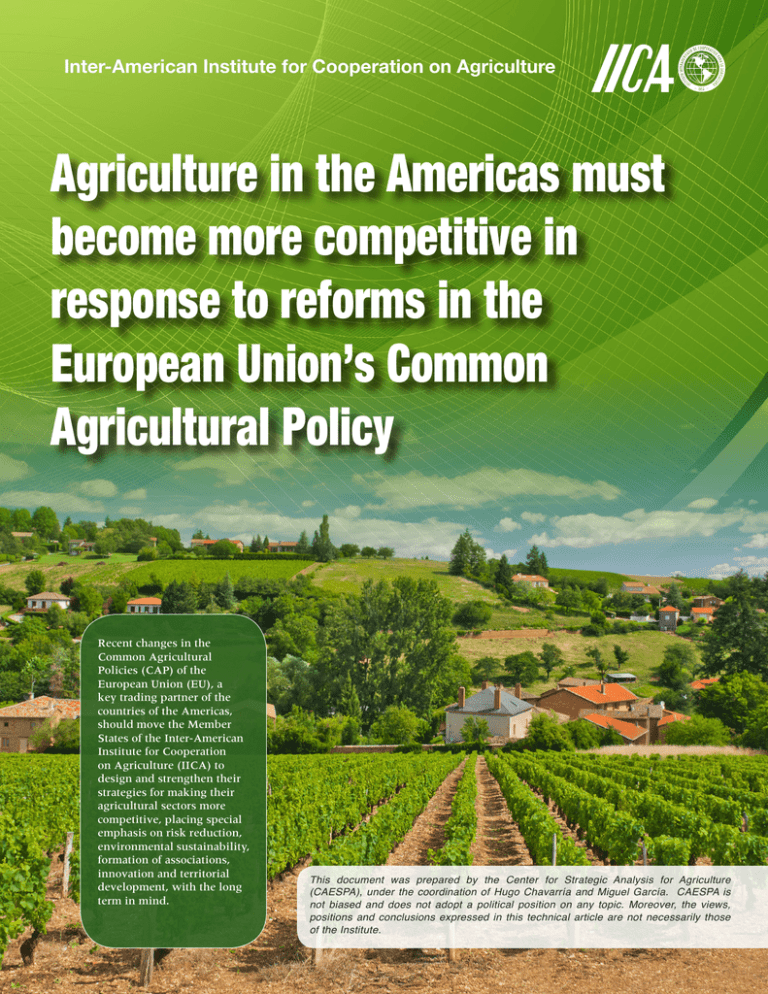
Inter-American Institute for Cooperation on Agriculture Agriculture in the Americas must become more competitive in response to reforms in the European Union’s Common Agricultural Policy Recent changes in the Common Agricultural Policies (CAP) of the European Union (EU), a key trading partner of the countries of the Americas, should move the Member States of the Inter-American Institute for Cooperation on Agriculture (IICA) to design and strengthen their strategies for making their agricultural sectors more competitive, placing special emphasis on risk reduction, environmental sustainability, formation of associations, innovation and territorial development, with the long term in mind. This document was prepared by the Center for Strategic Analysis for Agriculture (CAESPA), under the coordination of Hugo Chavarría and Miguel García. CAESPA is not biased and does not adopt a political position on any topic. Moreover, the views, positions and conclusions expressed in this technical article are not necessarily those of the Institute. Agriculture in the Americas must become more Competitive in Response to Reforms in the European Union’s Common Agricultural 1 T he EU is the destination market for more than 15% of the agricultural exports of the American hemisphere, and also the principal foodexporting region in the world (120 billion euros in 2013). It is therefore important to be informed of any event affecting that region’s agriculture and food sector, including changes in its agricultural policy. This will facilitate the development of strategies to enable IICA’s member countries to strengthen their competitive positions. This technical note was prepared by IICA’s Center for Strategic Analysis for Agriculture (CAESPA) for the Ministers of Agriculture and IICA’s offices in the Member States, with the aim of presenting a summary of the most relevant changes to the European Union’s CAP, approved for 2014-2020. The EU (formerly the European Economic Community) has had a common agricultural policy for more than 50 years, aimed at promoting food production, making food accessible to its citizens, fostering the region’s agricultural competitiveness in international markets and improving living conditions in rural areas. Given the importance attached to agriculture and rural life in the region, the EU finances the CAP, which is implemented at the national level by each member country. Thirteen new members have joined the EU since the CAP was last reformed, in 2003. As a result, the region agreed it was necessary to review its agricultural policy, in order to focus its support on the new rules of the market and to respond to the new economic, environmental, and territorial challenges faced by agriculture in the region. In late 2013, the European Council and Parliament agreed on the final version of the CAP reform that will govern for the 2014-2020 period. The main objectives of the new reform are to promote viable food production, the sustainable management of natural resources, and balanced development in rural areas. As in the case of earlier reforms, this reform is intended to serve as an instrument for achieving a financially sustainable and competitive agricultural sector, with highly efficient value chains that contribute to development in the rural economy. As in the case of the previous CAP, this one also rests on two main pillars: “direct payments and market-support measures” and “rural development.” These pillars, in turn, are divided into three complementary instruments: 1) Direct payments to farmers, contingent upon on strict compliance with food security, environmental protection, and animal health and welfare standards (new basic payment scheme, “greening,” and voluntary coupled support, among other things) 2) Market-support measures to be applied when circumstances (for example, bad weather) destabilize markets 3) Rural development measures intended to contribute to famers’ efforts to promote the competitiveness, sustainability and development of rural communities. In nominal terms, the funds allocated to the CAP each year for the 2014-2020 period did not change relative to the amounts allocated under the previous legislation; however, in real terms the budget will shrink by around 13% (2011 prices), as shown in Table 13. 1. The reform will enter into force on 1 January 2015, except for the market-support measures, which went into effect on 1 January 2014 2. On average, direct payments represent about 30% of EU farmers’ incomes. However, in countries such as Sweden, Ireland, and Denmark, direct payments have come to represent 60% of farmers’ incomes. (EU, 2013) 3. The budget freeze resulting from these reforms highlight a trend to lower the Cap’s share in the EU’s total budget. In 1980 the CAP represented 70% of the EU’s budget; currently it accounts for only 38%. 2 Inter-American Institute for Cooperation on Agriculture Table 1. CAP budget 2014-2020 (billions of euros) Current 2011 prices prices adaptation measures, including the establishment of organic farms, the provision of environmental services, the maintenance of natural conservation areas and the attraction of investments in forestry activities. Pillar I: Direct payments and market-support measures €312.74 €277.85 Pillar II: Rural development €95.58 €84.94 Total €408.31 €362.79 Source: Agricultural Policy Perspective Brief. Overview of CAP Reform 2014-2020. No 5. December 2013. The principal changes in the new CAP are: PROMOTE ENVIRONMENTAL SUSTAINABILITY The biggest change in the present reform is the inclusion of “green payments” (“greening”) to promote the provision of public environmental goods by farmers. According to the new CAP reform, 30% of direct subsidies to farmers (pillar I) will be contingent upon the mandatory implementation of certain environmentally friendly farm practices. Some of the specific measures included are: • To produce at least 2 – 3 different crops on the farm (the number of crops will depend on farm size) and the main crop may not cover more than 75% of the arable area • • To maintain a minimum amount of permanent pastures or vegetation (at least equal to the amount set aside for this purpose in 2012) To preserve areas of ecological interest (up to 5% on farms larger than 15 hectares). In addition, at least 30% of each rural development program (pillar II) should be aimed at the implementation of voluntary measures that will benefit the environment and support mitigation and climate change EFFICIENCY AND EQUITABLE REDISTRIBUTION OF RESOURCES In order to improve efficiency in the use of resources, channel support to the neediest, and distribute such support more equitably (among Member States and within them), the newly approved CAP reform includes some new directives aimed at: i) Providing support only to those farmers who are actively farming and whose main activity is agriculture ii) Creating simpler payment systems for smallholders, to ensure that farms under 30 hectares receive their supports quickly and easily iii) Setting limits on the support received by to large farms or large beneficiaries, under the new basic payment scheme and the single payment scheme or single area scheme, with remaining resources being channeled to rural development programs iv) Providing a supplementary payment of 25% to farmers under 40 years of age who become farmers for the first time, or have become such in the five years leading up to the reform v) Allowing the use of up to 13% of the funds for production support in areas where agriculture is experiencing great difficulty due to social, economic, or environmental situations4. Farmers should be rewarded for the services they deliver to the wider public, such as landscapes, farmland biodiversity, and climate stability (European Commission, 2013) 4. These funds may be increased by an additional 2% with the introduction of a specific support for high-protein crops. Agriculture in the Americas must become more Competitive in Response to Reforms in the European Union’s Common Agricultural 3 Figure 1. Changes in the distribution of direct CAP payments EUR/ha (current prices) 800 700 600 500 400 300 200 100 0 MT NL BE EL IT CY DK SI DE FR LU IE Baseline for CAP reform (EUR/ha) EU AT HU CZ ES FI SE EG UK FL FT SK HR RD LT EE LV CAP reform agreement (EUR/ha) EU average - CAP reform agreement (EUR/ha) 90% of EU average - CAP reform agreement (EUR/ha) Source: Agricultural Policy Perspective Brief. Overview of CAP Reform 2014-2020. N.o 5. Diciembre de 2013. vi) Supporting agricultural advisory systems and agricultural training and innovation programs in order to accelerate the transfer of knowledge vi) Granting the EU countries greater flexibility in implementing the combination of supports that best suit the needs of their agricultural sectors and rural areas (up to 15% of the budget assigned to each country may be transferred between the two pillars) As part of the CAP reforms, new instruments have been introduced to encourage farmers to base their decisions on market signals. Of special importance is the elimination of restrictions on production volumes and quotas for sugar, dairy products and wine, the original purpose of which was to control imports, which created upward pressure on their prices. vii) Reducing the variability of direct payments (pillar I) among EU countries by defining minimum per-hectare supports, based on an average of all the Member States rather than on historical criteria, to be fully implemented in 2019 To offset the impact of more open markets and as part of a risk management program for local farmers, the CAP reforms include a € 400 million-a-year fund (2011 prices) under pillar I, intended to enable them to respond more effectively to possible crises in agricultural markets. viii)Reducing the variability of direct payments within countries by establishing a per-hectare minimum, calculated at the national or regional level, rather than basing same on historical criteria. This will reduce perhectare supports in some countries and increase them in others, as can be seen in Figure 1. 4 RISK MANAGEMENT AND PUBLIC PARTICIPATION IN MARKETS Inter-American Institute for Cooperation on Agriculture The reforms to the CAP call for a gradual opening of domestic markets to certain agricultural commodities. In this connection, instruments are also created for managing farmers’ risk and crises in domestic markets. Noteworthy are new special safeguards in all sectors that can be used in the event of market disturbances. Moreover, to provide safety nets for farmers and ensure local supply, new mutual funds and guarantee mechanisms have been created for accessing productive assets; programs have been maintained and bolstered for the public storage of beef, barley, corn, wheat, rice, butter, and powdered milk; and the European Commission may now be able to review the reference prices considered when applying intervention measures (public intervention and private storage aid, taking into account the trends in market prices and production costs). Pillar II also provides new risk management tools, ranging from insurance for harvests, animals, and plants, to mutual funds and tools for stabilizing farmers’ incomes. To promote the competitiveness of producer groups, new programs have been added to reduce production costs, facilitate access to softer credits and add value in the early stages of production. OTHER CHANGES In order to improve scale, lower transaction costs and facilitate farmers’ access to credit (mainly small-scale producers), both pillars offer incentives that encourage cooperation and the formation of associations. To this end, pillar II has earmarked funds to strengthen the legal mechanisms that regulate and encourage farmer organizations. Funds have also been included under pillar II of this new CAP to help bridge the gap between the generation of scientific knowledge and its application. This will be done by strengthening the farm advisory system and upgrading farmers’ capacities through cooperative programs. These supports are intended to facilitate the adoption of new technologies and instruments that will enable farmers to operate more efficiently and respond more effectively to current challenges. CONCLUSIONS Continuity: In general, the CAP reforms represent a continuation of the policy instruments used during the last 10 years to support agriculture in the European Union. Although the reforms aim to improve the distribution of agricultural supports among the EU’s Member States and mandate adherence to environmentally friendly farm practices, the newly approved CAP will continue to use direct payments to farmers, market intervention measures, and support for rural development as instruments to strengthen domestic food production and improve the living conditions of its farmers. Actually, the changes approved in the final version of the CAP are less drastic than those proposed in the first drafts of the reform. A further decoupling of market support: Although the approved version of the CAP does not change the share of direct payments in the total CAP budget, and since 70% of payments continue to be associated with measures that many trading believe create distortions (coupled payments, price supports, export subsidies, among others), the fact is that direct payments have been further decoupled from market variables. This is because historical averages have been replaced by support measures in the Member States, and because 30% of total supports are contingent upon the implementation of environmentally friendly practices. In addition to being less pervasive, coupled supports only apply to certain sectors and their purpose is not to increase production. Although certain instruments, such as support prices and export subsidies, are still found in the new reform, they are not budgeted and will only be applied in the event of crisis. Greater trade opportunities: The greater opening of European markets to agricultural commodities such as sugar, dairy products, and wine, will offer trade opportunities to exporters in the Americas (especially Brazil, Belize, and the Dominican Republic for sugar), and Chile, United States of Ame- Agriculture in the Americas must become more Competitive in Response to Reforms in the European Union’s Common Agricultural 5 Figure 2. Share of products in the agrifood exports of the Americas and Europe (2 digits) - 2013 Share in European exports Figure 2. Share of products in the agrifood exports of the Americas and Europe (2 digits) - 2013 Share in the exports of the Americas Source: IICA (CAESPA) with ITC data (Comtrade) rica, and Argentina for wine (no country of the Americas has a large share of dairy imports in the European Union). These countries have already positioned themselves in the European market and their quotas may increase. According to some analysts, this was another reform that didn’t go far enough. The timeframes for lifting production restrictions and import quotas are greater than those initially proposed (2017 for sugar), providing the regional market a longer period of protection. In addition, the elimination or restriction of these quotas may be offset by the creation of new special safeguards. IMPLICATIONS FOR IICA’S MEMBER STATES Given the priorities and instruments established in the CAP, the countries of the Americas need to design and strengthen strategies to make their agricultural sectors more competitive. They also need to focus attention on issues of importance worldwide, such as risk 6 Inter-American Institute for Cooperation on Agriculture reduction, environmental sustainability, promotion of farmer organizations, innovation and technology adoption, and territorial development. In addition to providing a long-term vision that will help lay the groundwork for a State policy, the strategies should include efficient and flexible policy tools and be adequately funded. While the policies should seek to strengthen agricultural competitiveness, they should also promote integrated rural development, especially in the most marginalized regions, encourage young people to farm, boost farmers’ capabilities, and be conducive to the generation of social innovations. The supports provided by the European Union to its farmers are of particular interest for agricultural export countries in the Americas, since the structure of the two regions’ agricultural export baskets is similar (the Herfindahl Hirschman concentration ratio is close to 0.67). For this reason, agriculture in the hemisphere could be affected if changes in direct payments, market interventions or support for rural development enable EU exporters to perform better in international markets, particularly the markets for meat products, dairy products, fruits, grains, and oils, all of which are of great importance for the exports of America (Figure 2). In short, IICA’s member countries should strengthen their efforts to develop long-term comprehensive agricultural policies, which, in addition to strengthening agricultural competitiveness, will enable them to meet current environmental requirement and achieve a balance in terms of development among regions and countries. DOCUMENTS CONSULTED Agroindustrial advisory services, Embassy of Argentina to the European Union. 2012. Common Agricultural Policy of the European Union. See http://bit.ly/1kxJAtz Agroindustrial advisory services, Embassy of Argentina to the European Union. 2013. Preliminary political agreement on the post-2013 reform of the European Union’s Common Agricultural Policy (CAP) (in Spanish). See http://bit.ly/1kxEttj Coordinadora de organizaciones de agricultores y ganaderos. 2013. Reforma del PAC 2013. See http://bit.ly/1jbiFyT European Commission. 2013. Agricultural Policy Perspective Brief. Overview of CAP Reform 2014-2020. No 5. December. See http://bit.ly/1jbiMdS European Union. 2013. CAP Reform: An explanation of the main elements. See http:// bit.ly/1kxLryB European Commission. 2013. The Common Agricultural Policy after 2013. See http://bit. ly/1kxHU3c European Union. 2013. The Common Agricultural Policy (CAP) and European agriculture: Frequently asked questions. See http://ec.europa.eu/agriculture/faq/index_ en.htm FAOSTAT. FAO database on production, commercial, and food statistics. See http:// bit.ly/1izyuFT Agriculture in the Americas must become more Competitive in Response to Reforms in the European Union’s Common Agricultural 7
